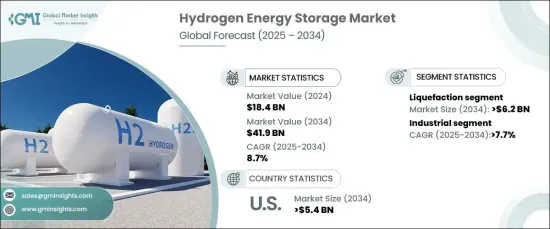 |
市场调查报告书
商品编码
1666582
氢能储存市场机会、成长动力、产业趋势分析及 2025 - 2034 年预测Hydrogen Energy Storage Market Opportunity, Growth Drivers, Industry Trend Analysis, and Forecast 2025 - 2034 |
||||||
2024 年全球氢能储存市场价值为 184 亿美元,预计将大幅成长,预计 2025 年至 2034 年的复合年增长率为 8.7%。氢能储存提供了一种有效的解决方案,它可以在发电量低的时期捕获多余的再生能源并将其转化为电能,确保可靠的能源供应。

氢储存技术的进步正在改变市场格局。压缩和低温液态氢储存方法由于其效率和可扩展性而变得越来越受欢迎。此外,基于材料的储存选项,包括金属氢化物和液态有机氢载体,为各种应用提供了更安全、更节省空间的解决方案。固态和基于氨的储氢系统等新兴技术也在积极开发中,进一步使该产业多样化。这些创新解决了与储存密度、运输和效率相关的关键挑战,加强了氢气作为可行能源载体的作用。
| 市场范围 | |
|---|---|
| 起始年份 | 2024 |
| 预测年份 | 2025-2034 |
| 起始值 | 184亿美元 |
| 预测值 | 419亿美元 |
| 复合年增长率 | 8.7% |
在储存方法方面,液化领域预计将出现显着增长,到 2034 年将达到 62 亿美元。随着全球脱碳努力的加强,这种方法支持了对清洁能源载体日益增长的需求。扩大对氢基础设施的投资进一步推动了液化技术的采用。
在应用方面,工业部门在预测期内的复合年增长率预计将超过 7.7%。各行各业越来越注重整合氢储存系统以提高能源效率并减少排放。氢气是各种工业过程中的关键组成部分,符合全球气候目标并支持向永续能源解决方案的过渡。
在再生能源和脱碳计画的策略性投资的推动下,美国氢能储存市场规模预计到 2034 年将超过 54 亿美元。该国承诺在2050年实现净零排放,加速了氢气生产和储存系统的发展。对来自再生能源的绿氢的重视凸显了其在该国能源转型策略中的关键作用。
目录
第 1 章:方法论与范围
- 市场定义
- 基础估算与计算
- 预测计算
- 资料来源
- 基本的
- 次要
- 有薪资的
- 民众
第 2 章:执行摘要
第 3 章:产业洞察
- 产业生态系统分析
- 监管格局
- 产业衝击力
- 成长动力
- 产业陷阱与挑战
- 成长潜力分析
- 波特的分析
- 供应商的议价能力
- 买家的议价能力
- 新进入者的威胁
- 替代品的威胁
- PESTEL 分析
第四章:竞争格局
- 战略仪表板
- 创新与永续发展格局
第 5 章:市场规模与预测:依方法,2021 – 2034 年
- 主要趋势
- 压缩
- 液化
- 基于材料
第 6 章:市场规模与预测:按应用,2021 – 2034 年
- 主要趋势
- 工业的
- 运输
- 固定式
- 其他的
第 7 章:市场规模及预测:按地区,2021 – 2034 年
- 主要趋势
- 北美洲
- 我们
- 加拿大
- 墨西哥
- 欧洲
- 德国
- 英国
- 法国
- 义大利
- 荷兰
- 俄罗斯
- 亚太地区
- 中国
- 印度
- 日本
- 世界其他地区
第八章:公司简介
- Air Liquide
- Air Products
- Cockerill Jingli Hydrogen
- Engie
- FuelCell Energy
- GKN Hydrogen
- Gravitricity
- Hydrogen in Motion
- ITM Power
- Linde
- McPhy Energy
- Nel
- SSE
The Global Hydrogen Energy Storage Market, valued at USD 18.4 billion in 2024, is poised for substantial growth, with an anticipated CAGR of 8.7% from 2025 to 2034. This growth is largely fueled by the rising adoption of renewable energy sources such as solar and wind, which are inherently variable and can create challenges in maintaining grid stability. Hydrogen energy storage offers an effective solution by capturing excess renewable energy and converting it into electricity during periods of low generation, ensuring a reliable energy supply.

Advancements in hydrogen storage technologies are transforming the market landscape. Compressed and cryogenic liquid hydrogen storage methods are becoming increasingly popular due to their efficiency and scalability. In addition, material-based storage options, including metal hydrides and liquid organic hydrogen carriers, provide safer and more space-efficient solutions for various applications. Emerging technologies such as solid-state and ammonia-based hydrogen storage systems are also under active development, further diversifying the industry. These innovations address critical challenges related to storage density, transportation, and efficiency, strengthening hydrogen's role as a viable energy carrier.
| Market Scope | |
|---|---|
| Start Year | 2024 |
| Forecast Year | 2025-2034 |
| Start Value | $18.4 Billion |
| Forecast Value | $41.9 Billion |
| CAGR | 8.7% |
In terms of storage methods, the liquefaction segment is expected to witness significant growth, reaching USD 6.2 billion by 2034. Its appeal lies in its ability to store hydrogen in a compact form with high energy density, making it suitable for large-scale applications. This method supports the increasing demand for clean energy carriers as global decarbonization efforts intensify. Expanding investments in hydrogen infrastructure further drive the adoption of liquefaction technologies.
On the application front, the industrial sector is projected to grow at a CAGR of over 7.7% during the forecast period. Industries are increasingly focusing on integrating hydrogen storage systems to enhance energy efficiency and reduce emissions. Hydrogen serves as a critical component in various industrial processes, aligning with global climate goals and supporting the transition toward sustainable energy solutions.
The U.S. hydrogen energy storage market is forecast to exceed USD 5.4 billion by 2034, driven by strategic investments in renewable energy and decarbonization initiatives. The nation's commitment to achieving net-zero emissions by 2050 has accelerated the development of hydrogen production and storage systems. The emphasis on green hydrogen, derived from renewable energy sources, highlights its pivotal role in the country's energy transition strategy.
Table of Contents
Chapter 1 Methodology & Scope
- 1.1 Market definitions
- 1.2 Base estimates & calculations
- 1.3 Forecast calculation
- 1.4 Data sources
- 1.4.1 Primary
- 1.4.2 Secondary
- 1.4.2.1 Paid
- 1.4.2.2 Public
Chapter 2 Executive Summary
- 2.1 Industry synopsis, 2021 – 2034
Chapter 3 Industry Insights
- 3.1 Industry ecosystem analysis
- 3.2 Regulatory landscape
- 3.3 Industry impact forces
- 3.3.1 Growth drivers
- 3.3.2 Industry pitfalls & challenges
- 3.4 Growth potential analysis
- 3.5 Porter's analysis
- 3.5.1 Bargaining power of suppliers
- 3.5.2 Bargaining power of buyers
- 3.5.3 Threat of new entrants
- 3.5.4 Threat of substitutes
- 3.6 PESTEL analysis
Chapter 4 Competitive landscape, 2024
- 4.1 Strategic dashboard
- 4.2 Innovation & sustainability landscape
Chapter 5 Market Size and Forecast, By Method, 2021 – 2034 (USD Million)
- 5.1 Key trends
- 5.2 Compression
- 5.3 Liquefaction
- 5.4 Material-based
Chapter 6 Market Size and Forecast, By Application, 2021 – 2034 (USD Million)
- 6.1 Key trends
- 6.2 Industrial
- 6.3 Transportation
- 6.4 Stationary
- 6.5 Others
Chapter 7 Market Size and Forecast, By Region, 2021 – 2034 (USD Million)
- 7.1 Key trends
- 7.2 North America
- 7.2.1 U.S.
- 7.2.2 Canada
- 7.2.3 Mexico
- 7.3 Europe
- 7.3.1 Germany
- 7.3.2 UK
- 7.3.3 France
- 7.3.4 Italy
- 7.3.5 Netherlands
- 7.3.6 Russia
- 7.4 Asia Pacific
- 7.4.1 China
- 7.4.2 India
- 7.4.3 Japan
- 7.5 Rest of World
Chapter 8 Company Profiles
- 8.1 Air Liquide
- 8.2 Air Products
- 8.3 Cockerill Jingli Hydrogen
- 8.4 Engie
- 8.5 FuelCell Energy
- 8.6 GKN Hydrogen
- 8.7 Gravitricity
- 8.8 Hydrogen in Motion
- 8.9 ITM Power
- 8.10 Linde
- 8.11 McPhy Energy
- 8.12 Nel
- 8.13 SSE









